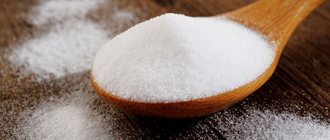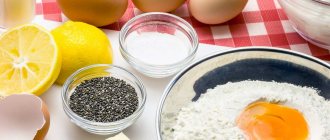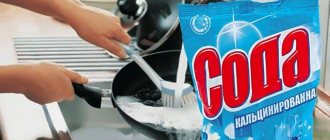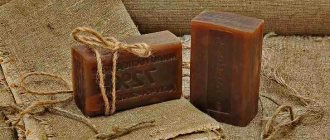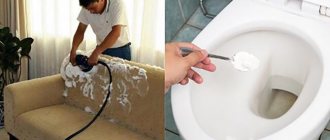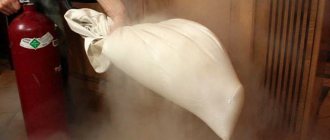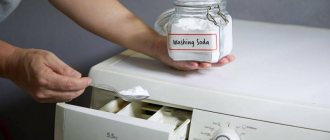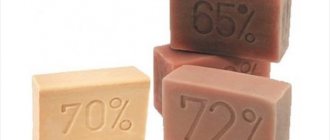Sodium bicarbonate is most often used in the form of a soda solution. Humanity became aware of the beneficial properties of soda not so long ago, but soda solution is already actively used in many areas of human life, once again demonstrating its positive effect.
Recipes for soda solutions that help overcome illnesses are very simple and accessible to everyone
Modern methods of producing soda
Baking soda (sodium bicarbonate) is an acidic salt of carbonic acid, a white, finely crystalline powder with a salty taste. Chemical formula – NaHCO3. This powder does not explode, does not burn and is non-toxic.
Currently, the production of purified sodium bicarbonate is carried out by two methods: “wet” and “dry”. The general process is based on a carbonation reaction where the solution is saturated with carbon dioxide. Thanks to this, recrystallization occurs; the methods themselves differ only in the preparation of the solution. So, with the first method, prepared soda ash is taken and dissolved with water, while with the second method, technical bicarbonate is used.
How to prepare a 2% soda ash solution at home is of interest to many.
Use in gardening
For the vegetable garden and garden, a 2% solution of soda ash is indispensable. Thanks to him you can:
- cope with powdery mildew, a disease of a number of cultivated plants that destroys young leaves of shoots;
- remove small grass that grows in the crevices of paths in the garden;
- rejuvenate rose bushes by adding a small amount of ammonia to a bicarbonate solution;
- eliminate caterpillars that eat young cabbage leaves;
- fertilize the tomatoes, and the fruits become even sweeter and meatier;
- acidify the soil to grow some crops;
- Clean your hands after work from stubborn dirt;
- protect grape bunches from gray berries, add sugar content to the berries.
Baking and pharmacy soda
Pharmacy products differ in composition from food products, and therefore the methods of their use differ somewhat. Baking soda includes:
It can be used externally to rinse the mouth and throat, but you need to be careful when using it internally, since frequent use may cause problems with the deposition of phosphate stones, blood pressure, intestines and stomach.
It is important to find out in advance how to prepare a 2 percent soda solution.
The pharmaceutical product is more strongly purified from impurities, and therefore it can be used externally, orally, and intravenously. How to properly use intravenous solutions, powders, rectal suppositories and tablets is described in detail in the instructions for use.
Depending on the scope and method of using sodium bicarbonate, you must choose pharmaceutical or baking soda.
So, how to prepare a 2 percent soda solution?
Rubdown
A more intensive method to reduce the temperature is rubbing with soda. To do this you need:
- prepare a small bowl with warm water, capacity 200 ml;
- dissolve 1 tsp. baking soda;
- moisten gauze or a small piece of cloth;
- wipe the child’s skin with gauze, namely the back, chest, stomach, rub the soles and palms especially well;
- After the procedure, the child needs to put on pajamas;
- put to bed.
Expert opinion
Attention!
You should not wrap your child warmly, as this may cause the temperature to rise again.
Recipe, dosage
To prepare a two percent soda solution, you need to use a universal formula: take 98 parts of ordinary water to 2 parts of soda.
When you need to make 100 ml of solution, you should mix:
A teaspoon contains approximately 7 g of the substance without a slide. But modern spoons have differences in volume (depending on the manufacturer), and therefore it is advisable to measure the amount of soda using scales.
Knowing how to prepare a 2 percent soda solution will definitely come in handy in practice.
Symptoms
The manifestation of symptoms depends on the toxic substance. The symptoms are always similar, the difference is in the degree of severity.
- constant feeling of nausea;
- repeated vomiting;
- general weakness and malaise;
- diarrhea;
- elevated temperature;
- change in skin tone.
Food poisoning manifests itself quite quickly. Symptoms of poisoning occur 1.5 - 5 hours after eating food. It is important to provide timely assistance and neutralize the toxic substance.
Contraindications and harm
The main reason for the negative effect of baking soda on the human body is its alkaline composition. If this product is used incorrectly, it may cause harm to your health. Many girls are now simply going crazy about losing weight with soda. However, it not only cleanses the body of various toxins, but also damages the gastric mucosa. It can be taken orally, but no more than twice a week.
Baking soda is contraindicated for people who suffer from ulcers and gastritis. Also, this product can be harmful during pregnancy or breastfeeding.
How to make a 2 percent soda solution is now clear.
Baking soda to suppress nausea
Baking soda not only induces vomiting, but also effectively suppresses nausea. For these purposes, you need to mix 15 grams of soda and 1 glass of water. The resulting solution must be drunk within 40-50 minutes. You should not eat food while taking it.
Doctors do not recommend long-term and regular use of soda solution to reduce acidity. According to doctors, baking soda should be used for treatment once, when there are no other first aid remedies at hand.
conclusions
To successfully use soda, you need to pay attention to how to make the solution correctly. You cannot mix proportions by eye and assume that the product will become a universal assistant. It is the excess amount of the active substance that in many cases causes a deterioration in the patient’s condition and the appearance of allergic reactions. In gardening, too strong a solution of soda can completely ruin the crop.
We looked at how to prepare a 2 percent soda solution.
Source
Video
How to properly prepare a soda solution
SODA - TAKE SODA CORRECTLY ACCORDING TO THE SCHEME! SOUGH JOINTS.THICK BLOOD.CLOGGED VESSELS - DRINK SODA DAILY
Attention! The information presented in the article is for informational purposes only. The materials in the article do not encourage self-treatment. Only a qualified doctor can make a diagnosis and give treatment recommendations based on the individual characteristics of a particular patient.
Found an error in the text? Select it, press Ctrl + Enter and we will fix everything!
Preparation and use of soda solution
Sodium bicarbonate is most often used in the form of a soda solution. Humanity became aware of the beneficial properties of soda not so long ago, but soda solution is already actively used in many areas of human life, once again demonstrating its positive effect.
Recipes for soda solutions that help overcome illnesses are very simple and accessible to everyone
What are the benefits of gargling with baking soda?
In order to get rid of some diseases in a short period of time, it is recommended not to waste time, but to immediately make a soda solution and start rinsing your mouth with it. You can gargle with soda for the following diseases:
- Pharyngitis.
- Angina.
- Stomatitis.
- Laryngitis.
How to gargle with soda solution correctly
Each time you rinse, prepare a new solution . If you prepared the solution in the morning, you cannot use it for rinsing in the evening. This may have a negative impact on your health.
To prepare the rinse solution, it is necessary to heat the water to a temperature slightly above room temperature.
Rinsing your mouth with cold water is strictly prohibited .
This will worsen the condition of your throat and mouth in general. The mixture should not be allowed to enter the stomach . This mixture has a detrimental effect on his mucous membranes.
The procedure should be done only after eating . It is better not to eat anything for 30 minutes after rinsing. Only in this case will it be possible to achieve a positive effect.
The effectiveness of baking soda for toothache
The result of exposure to the substance occurs due to the following benefits of soda:
- relieves the inflammatory process;
- dulls the sensitivity of the diseased nerve;
- stops the spread of pathogenic bacteria;
- enhances the impact of traditional remedies;
- has a powerful antiseptic effect;
- protects healthy areas from the spread of harmful organisms;
- does not cause allergic reactions or poisoning;
- It is easily tolerated at any age and does not have a negative effect on the kidneys or other organs.
Attention! In addition to relieving toothache, the substance also has an inhibitory effect on other bacteria found in the oral cavity. This makes it possible to cure candidiasis and heal minor mucosal problems.
How to prepare and where to use the product
Soda solution is widely used in various areas of human activity. Sodium bicarbonate itself in dry form is used in industry and cooking, but soda solution is most in demand in gardening, medicine and cosmetology.
It is very easy to prepare the product - the required amount of white powder is added to the liquid and mixed until the particles are completely dissolved. Most often, soda is mixed with water, but for the treatment of certain ailments, sodium bicarbonate is more beneficial with milk than with water. But in cosmetology, a soda solution is made on the basis of shampoo, which is used to wash hair.
Despite the fact that it is easy to make a soda solution, when preparing it it is important to correctly observe the proportions of the recommended substances.
Otherwise, the product may become not only useless, but also harmful.
Causes of acidosis
Why does an imbalance of acid-rich hormones towards oxidation (acidosis) occur? The causes of the pathology may be:
- preservatives and pesticides;
- unfavorable environment;
- drug abuse;
- emotions of fear, anger and anxiety.
Why does a disturbance in the emotional sphere lead to acidosis? Because with negative emotions, the activity of the kidneys is disrupted, which are unable to coordinate the alkaline balance of the blood. Severe acidification of the blood leads to various ailments.
Application in medicine
Soda solution is a real savior from many diseases. Some doctors even insist that sodium bicarbonate can cure cancer.
Gargling with a baking soda solution very quickly and significantly relieves discomfort in the throat.
However, while research on the effect of soda on cancer pathology is still ongoing, we can say with confidence that this substance can cope with many ailments:
Fungus treatment
A soap-soda solution is used at the early stage of the disease. The product allows you to get rid of unpleasant odor, itching and flaking, and restore the integrity of the skin.
Solution recipe:
- Pour 3-6 liters of water into a clean basin, add 20 g. soap shavings or the same amount of liquid laundry soap;
- add 30 gr. soda You can use 4-5 drops of tea tree oil to enhance the healing effect;
- Immerse your feet or hands in the bath.
For sensitive skin, use category III laundry soap (64%).
The procedure lasts 10 minutes. This should be repeated every evening after basic hygiene procedures. Treatment will take from several weeks to 6 months, depending on the area of the lesion.
Read more: Foot baths with soda for fungus.
Washing, cleaning, cleaning, driving out insects? That's right, soda ash!
Soda ash (formula Na2CO3) will successfully replace the expensive chemicals that we use every day. It can be used to clean, wash, wash, remove blockages in drain pipes, and remove unpleasant odors.
Gardeners use it to control garden weeds and treat plants. The scope of use of soda ash at home is quite wide.
Just a couple of decades ago, every housewife had a pack of soda ash on her shelf. When there was no such choice of detergents, there was no alternative. Today they forgot about it, but in vain.
What is the secret of the action of sodium carbonate, how to use it correctly? Can this cheap powder really solve most household problems?
The material turned out to be voluminous, but no less useful for that. Buckle up and sit comfortably. Here we go?!
What are the pros and cons?
The main advantages are the availability of ingredients, ease of preparation, effectiveness and safety. Among the key advantages, experts highlight the following points:
- quickly relieves pain and inflammation,
- removes plaque and cleanses enamel, freshens breath,
- stimulates the healing of microtraumas and wounds on the mucous membrane,
- inhibits the formation of dental plaque,
- strengthens hard and soft tissues - the composition is useful for both teeth and gums,
- Easy to prepare from simple and affordable ingredients - a good budget option.
The disadvantages include unpleasant sensations due to enamel hyperesthesia, as well as a specific taste, which in rare cases causes attacks of nausea. In addition, the composition only relieves symptoms, but does not treat the disease itself, so its use is good before or after visiting a doctor, and then only as maintenance therapy.
What is the difference between soda ash and baking soda and caustic soda?
We go to the store for soda ash. Not to be confused with food grade and caustic. It is sold in laundry departments.
This is interesting! Soda was known to man approximately one and a half to two thousand years BC. The ancient Egyptians used natural soda extracted from lake waters. Used as a detergent and also for melting glass.
Soda ash is used only for technical purposes. International name: Sodium carbonate. Chemical formula: Na2CO3, synonyms: Sodium carbonate, Sodium carbonate.
Available in the form of powder (grade B) or granules (grade A) white. The product is highly hygroscopic, and in aqueous solutions it has a strong alkaline reaction.
Soda ash, baking soda and caustic soda are salts of carbonic acid with varying degrees of acidity. In the table below you can see the differences between these substances.
| Types of soda | Formula | pH | Chemical name | Hygroscopicity/Appearance | Hazard Class | Fire/Explosion Hazard |
| Food | NAHCO3 | 8 | Sodium bicarbonate | +/white crystalline powder | Non-toxic | — |
| Calcified | Na2CO3 | 11 | Sodium carbonate | ++/colorless crystalline powder | 3 | — |
| Caustic | NaOH | 13 | Sodium hydroxide | +++/white hard scaly mass | 2 | -/+ when heating |
Conditions and periods of storage of soda ash
Soda ash is a crumbly, lump-free powder. Shelf life is 5 years, provided that it is stored in special packaging. It actively absorbs moisture and carbon dioxide from the air if it is open. In a humid atmosphere, upon contact with air, it cakes and loses its properties.
At home, after opening the package, it is best to store soda ash in a glass container covered with a plastic lid. The jar must be labeled so as not to confuse it with food products.
Carefully! If soda ash gets into the digestive tract, serious, intractable, long-lasting burns can occur. Avoid placing a can of baking soda on food shelves where it could be confused with salt, sugar or flour. Keep out of the reach of children. The container with soda ash must be labeled.
If soda is stored in paper packaging, then after opening it can retain its properties for no more than 25 days.
Instructions for use: solutions, soap, paste, gel
Sodium carbonate is widely used in everyday life by those housewives who are accustomed to saving not only money, but also time. To restore order in the kitchen or bathroom, you need several types of household chemical products. A packet of soda ash can replace them.
It can clear blockages in pipes, remove stubborn dirt from kitchen surfaces, clean ceramics, tiles, enamel and porcelain dishes, wash clothes, bleach bed linen, disinfect the house, and remove layers of old paint.
Cleaning kitchen appliance surfaces
Sodium carbonate is indispensable in the kitchen, if you need to quickly clean work surfaces, microwaves, ovens, refrigerators, and hoods.
Add 3 tablespoons of soda ash to 1 liter of warm water and mix well until dissolved. You can shake it in a plastic bottle.
Using a spray or sponge, apply the solution to the surfaces to be cleaned; after 5 minutes, dirt and grease are easily removed with a napkin. After using the soda ash solution, rinse the treated surfaces with clean water and wipe dry.
Gas, electric stoves and ovens will shine
A solution with silicate glue will help to wash heavily soiled surfaces, grates of gas stoves, electric ovens, gas and electric ovens.
For 1 liter of water, take 3 tablespoons of soda ash, 1 tablespoon of washing powder, 1 tablespoon of silicate glue. Shake thoroughly.
Apply the working solution generously to the surfaces to be cleaned and leave for 10 minutes. Then remove softened dirt, grease and carbon deposits with a damp sponge. If the plaque is not completely removed in one procedure, the treatment is repeated.
Store alkaline solutions in tightly closed containers with a label attached. Before next use, do not forget to shake.
Valuable advice about cleaning a microwave oven in the review:
Maria Prokorpenko. Krasnodar. I put the soda ash solution in the microwave and turn it on at full power for 5 minutes. After 5 minutes, all that remains is to wipe off the swollen fat with a damp cloth.
A product for quickly descaling a kettle
Cleaning heavily soiled frying pans, pots and pans from carbon deposits - video recipe
Enameled pots, ceramic, cast-iron frying pans, cauldrons with frequent long-term use require periodic global cleaning of ingrained dirt, grease, and carbon deposits. Boiling the dishes in a solution with soda ash will help you successfully cope with the problem.
Place the dishes in a large steel basin or tank and fill with water until it completely covers the contents. Pour out 1 pack of sodium carbonate, 200 grams of grated laundry soap, pour in 2-3 bottles of silicate glue.
The boiling time depends on the degree of soiling of the dishes. It can range from 20 minutes to an hour.
Alla Kovaleva, Orel. I use this method when we visit my grandmother in the village for the summer. Boil all the dishes. After a couple of hours everything shines. There is no hot water, and grandma is unable to do general cleaning. All the dirt flies off right before your eyes. We boil plates, cups, forks, spoons, teapots. All stainless steel and enamel.
Washing dishes - plates, cups, spoons, forks
The already familiar Na2CO3 solution is well suited for washing dishes: 3 tablespoons per 1 liter of water. Just moisten a kitchen sponge with it and wash plates, cups and other small kitchen items. Then rinse with running water. This procedure will ensure not only cleanliness, but also disinfection of the dishes.
How to rinse
Recommendations for rinsing the mouth with soda:
- Since tooth enamel is very sensitive, this method must be used in combination with strengthening the enamel (consumption of vitamins, fruits and vegetables).
- The rinsing procedure should not exceed 10 days.
- It is best to rinse after brushing your teeth.
- After exposure to soda, you should not drink or eat food for half an hour.
- At the end of the procedure, you should thoroughly rinse your mouth with clean water.
- If you are experiencing severe pain, for each rinse it is better to prepare a fresh solution that has not yet lost its beneficial properties.
- In order not to harm the health of internal organs, you should try not to swallow the soda solution.
- Rinse time should be 2–5 minutes.
The solution is used warm so as not to provoke tooth sensitivity to cold or hot.
Washable, but only for cotton and linen
Did you know that soda ash is called washing soda, and this is no coincidence. Sodium carbonate does an excellent job of soaking, hand and machine washing, boiling and removing stains.
Only one “but”! Washing with soda ash is only suitable for cotton and linen. Sodium carbonate should not be used on wool, silk, synthetics, or lace. Such solutions are not suitable for leather, suede, or items made from membrane fabrics.
Soaking laundry - 100% success
If white linen has lost its original appearance, soaking it in a sodium carbonate solution will help restore its whiteness. Soda ash is dissolved in water at the rate of 3 tablespoons per 5 liters of water and the laundry is soaked overnight. If the laundry is very dirty or “washed”, it must first be soaped with laundry soap. After 8-10 hours, the laundry is wrung out, rinsed and washed. The result is that your snow-white sheets and duvet covers will look like new.
When soaking colored laundry, you need to take into account that aggressive alkali can “eat” the paint. The proportions are slightly different: 3 tablespoons per 10 liters of water. You should also not boil colored linen in a solution of soda ash.
Irina P., Chekhov. My mother soaked the laundry. Usually at night. I don’t know what she added to the water. Then I washed it by hand and dried it on a line in the yard. Everything was snow-white and fragrant with freshness. This effect cannot be achieved in a washing machine. I'll have to try this method for white linen, I think it will work.
Hand wash - easy!
Hand washing using soda ash should only be done with rubber gloves. You need to work carefully so that splashes do not get into your eyes or mouth. If the working fluid gets on the skin, it is necessary to rinse it with running water, dry it and lubricate it with a rich cream.
When added 1 tablespoon per 10 liters, soda ash softens water and makes laundry detergents and soaps more effective.
Machine washing will be even more effective
When machine washing, adding carbonate will help remove limescale and scale. Na2CO3 will soften water, improve the effectiveness of washing powder or gel, and remove stains and stubborn dirt from laundry.
When using inexpensive laundry detergent, add 3 tablespoons of sodium carbonate per load of machine. Wash at temperatures from 50 to 100 degrees.
Solution for boiling laundry
For high-quality bleaching of linen and its disinfection, boiling is used. To 10 liters of water add 500 g of soda ash and 500 ml of “Whiteness”. Boil the laundry, stirring, for 40 minutes - 1 hour. Try not to breathe in the fumes. Keep indoor windows open.
Do not use aluminum or copper utensils for boiling, as sodium carbonate reacts with them. As a result, the laundry may become stained.
Marina Petrovna, Zlatoust. I boil white tablecloths and napkins in a solution of soda ash. I just didn’t know that the embroidery would fade. The little blue flowers turned almost white. So choose - say goodbye to stains or say goodbye to embroidery.
Washing gel
Boil 2 liters of water in an enamel bowl, add 100 g of grated laundry soap. When the soap flakes are completely dissolved, add 150 g of soda ash. Let the mixture simmer for 3 minutes, turn off the heat.
After the mixture has cooled, add 2 tablespoons of cosmetic glycerin and a few drops of any flower oil. Use the gel for hand washing.
How to make homemade soap - step by step instructions
The molds with soap are sent to a cool place to mature. A month later the soap is ready.
This soap will be good for washing your hands after gardening or working in the garage, washing contaminated clothes and removing stains, and boiling laundry. It works more effectively in hot water, not lower than 40 degrees.
Leaf skeleton for decoration
Do you want to decorate a glass vase or create an artistic panel from leaves? Soda ash will help you with this. In 30-40 minutes you will receive a masterpiece of nature - the skeleton of a leaf, with a bizarre pattern of bleached veins. Such lace leaves are a space for inspiration and creativity.
Take a low saucepan, pour 1.5 liters of water into it, bring to a boil and dissolve 10 tablespoons of soda ash in boiling water.
Dip the prepared leaves into the hot solution and close the lid. Simmering time on low heat is 30-40 minutes.
Then, one at a time, remove the leaves with tweezers, lay them out on paper, and remove the remaining particles with a brush.
Place the “skeletons” on a sheet of paper and dry. They can be painted, glued, varnished. Use for creativity: creating panels and paintings, postcards, jewelry, decorating glass products.
How to properly use the rinse solution?
The prepared solution can be used as a main or combined remedy when tooth pain occurs. To prepare the medicine, you need to take 200 ml of warm boiled water, and its temperature should be between 37-40 degrees. A teaspoon of the substance is taken for this amount of liquid; it is important to mix everything well.
The prepared solution should be used immediately, as its effect weakens over time, which may reduce the effectiveness of treatment. During the procedure, it is recommended to take a little water, 15-30 ml is enough, and rinse the sore spot with it for a few seconds. After this, the water is spat out and new water is collected.
The prepared soda solution should be used immediately, as its effect weakens over time.
Attention! You can rinse a sore tooth in this way up to five times per day. It is also necessary to use a soda solution after each meal so that food that gets into the carious pocket does not cause pain and further destruction.
General cleaning one-two-three
The following recipes are good for disinfecting kitchen surfaces, plumbing fixtures, kitchen floors, toilets and bathrooms.
The first composition is weaker, the second is stronger.
Surfaces are treated with a disinfectant solution using a sprayer. After 5 minutes, dirt can be easily removed with a soft cloth or sponge.
All-purpose floor and tile cleaner
Dilute 2-3 tbsp in 5 liters of warm water. l. soda ash and 2-3 tbsp. l. liquid soap.
The resulting product is added to the water for washing the floor. And in case of heavy contamination, spray evenly over the surface. After 5-10 minutes, dirt can be easily removed with a sponge. Then the floors are wiped with a damp, clean cloth.
Attention! It is not recommended to clean wooden and brick surfaces, parquet, laminate, suspended ceilings, surfaces painted with enamels or varnish with soda ash solutions.
Oleg Paramonov, chemist. When using soda ash at home, we must not forget that it is an aggressive alkali. You need to work in rubber gloves and do not inhale fumes during thermal procedures. In case of contact with the skin and mucous membranes, or if swallowed, solutions of soda ash can cause burns and cause irreparable damage to health. Keep sodium carbonate out of the reach of children, in a closed container, away from foods and medications. Soda ash and safety measures are two inseparable concepts.
Beneficial features
Soda is a rather weak and at the same time generally available antiseptic. Therefore, rinsing the mouth with it, when indicated for this, is perceived quite favorably by doctors. Soda solution can also be used against heartburn, but this increases the likelihood of “acid rebound” - a phenomenon in which, some time after taking soda powder dissolved in water, gastric acidity sharply increases. In medicine, this is explained by the fact that when too much alkali enters the stomach, the formation of hydrochloric acid accelerates.
However, when other medications are not available, soda can be used to achieve a certain therapeutic effect. So, at home, sodium bicarbonate will help with:
- diseases of the mucous membranes of the mouth, gums and throat (perhaps the use of soda to rinse the teeth and throat is one of the most effective and safest methods of its use);
- heartburn (in this case, soda should be used carefully, as an “acid rebound” may occur);
- insect bites (the affected area is smeared with a paste of water and soda);
- cough with sputum too viscous to liquefy it (first of all, the patient needs to be provided with proper care and only after that give him a small amount of warm milk with soda and honey, but if we are talking about treating babies, this drink is allowed to be taken only in the first half of the day , it is prohibited to use it before bedtime);
- plaque on the teeth (whitening with soda will necessarily thin the enamel, cause discomfort from cold and hot food, and can subsequently lead to damage to the teeth);
- rough skin on elbows, feet, etc.
Soda ash and its use in the garden
Gardeners and gardeners have long appreciated the effectiveness of soda ash for protecting plants from diseases and pests.
In this video, the author shares his experience of using soda ash in his summer cottage and offers his original recipe:
Anti-powdery mildew
Fungal infection of plant leaves, similar to a scattering of flour, often affects vegetable crops and berry bushes. The result of this pest is loss of yield and death of the plant.
To prevent this from happening, at the first signs of the disease it is necessary to spray with a solution of 50 g of sodium carbonate per 10 liters of water. To make the working fluid stick, add 40 g of laundry soap or 50 ml of dishwashing liquid.
Spraying is carried out once every 7-10 days during the outbreak of the disease.
Against gray rot
Gray rot affects almost all vegetable crops in cool, rainy weather. Gray rot is especially dangerous for strawberries. Spraying will replace treatment with copper sulfate, Bordeaux mixture, Topaz, Oxychom, and Champion.
Solution recipe: 4 tbsp. Dilute tablespoons of soda ash in a liter of warm water and pour into a bucket with 9 liters of water. Water the plants from above using a watering can.
Control of leaf-eating insects and caterpillars
If you notice holes in the leaves, look for leaf-eating parasites. Soda ash comes to the rescue in this case too.
You need to treat the leaves from the underside with a solution of 1 tablespoon of soda per 10 liters of water and 40 g of soap (green, laundry or tar).
Saving cabbage
Cabbage moth, white butterfly, moth, cutworm - all pests will disappear if you treat the plants with soda ash. Mix soda and flour 1 to 1 and sprinkle generously over the sheet through a fine sieve.
To prevent the invasion of slugs, dust the cabbage and beds with a mixture of 1 cup of soda and half a bucket of wood ash.
From aphid invasion
Even the most well-groomed summer cottage will lose its attractiveness if it is colonized by colonies of aphids, small leaf-sucking insects.
To combat the pest, spray the affected leaves with the following solution: for 10 liters of water, 1 tablespoon of soda ash, a glass of onion pulp. For better adhesion, you can add 50 ml of any liquid soap.
Attention! You can eat fruits after spraying with soda ash after 25 days.
Rose rejuvenation and weed control
There is a simple but effective recipe for rejuvenating rose plantings. Once every 10 days it is necessary to generously spray the plants on the leaves with the following solution:
A concentrated solution of soda ash (5 tablespoons per 10 liters of water) is used as a herbicide in the fight against weeds. To do this, one treatment in dry, hot weather is sufficient. The weeds will soon turn yellow, dry out and disappear.
How to treat shrubs?
During the ripening period of grapes, it is important to protect the berries from gray rot. For prevention and at the first symptoms of damage, spray with a solution of 70-80 grams of soda per 10 liters of water.
Treatment of gooseberries and currants from yellowing and premature shedding of leaves with a solution: 1 glass of sodium carbonate per 10 liters of water.
Interesting fact. After treatment with a solution of soda ash, the taste of grapes, tomatoes, gooseberries and currants significantly improves. They acquire additional sweetness.
We increase the yield of cucumbers and at the same time expel ants
Watering at the root with a solution of 1 tablespoon will help prevent diseases of cucumbers. soda ash in a bucket of water.
To prevent ants from eating up young plants of cucumber, tomato and peppers, you need to sprinkle the places where they accumulate and anthills with dry soda powder. You can mix baking soda with wood ash.
How to find out the acidity of the soil?
If you want to know whether the soil in your area is acidic or alkaline, do a little experiment. Take 2 glass jars, pour in the same amount of water, add a handful of earth and mix. Add vinegar to one jar. If the water hisses, it means the soil is alkaline. The water did not hiss, which means the soil is most likely acidic or neutral.
Pour soda ash into another jar. When exposed to an acidic environment, soda will begin to produce bubbles. If bubbles appear, the soil is acidic.
If there are no bubbles in either the first or second jar, congratulations. The soil in your area is neutral, which means it is suitable for most plants.
For lush flowering
If you have flowers that prefer alkaline soil, soda ash will make them bloom beautifully. Geraniums, begonias and hydrangeas benefit greatly from watering with a weak solution of baking soda, 1 teaspoon per 5 liters of water.
Manufacturing companies, brands of sodium carbonate
Technical soda ash is produced in Russia by several enterprises:
Grade A is used in glass production, ferrous and non-ferrous metallurgy.
Brand B is used in the production of synthetic detergents, in the pulp and paper, aniline dye, paint and varnish, and oil industries. In chemical production - for the synthesis of fatty acids, purification of brines, in the production of carbonate-containing raw materials, glycerols and alcohols.
Where is soda ash used?
The use of soda ash in various areas of Russian industry is diverse. About half of the sodium carbonate goes into glass making, about a quarter goes into chemicals, 13% into soaps and detergents, 11% goes into such uses as pulp and paper making, metal and petroleum refining, leather tanning and water purification, and the rest goes to sale.
There are many different uses of soda ash in everyday life:
